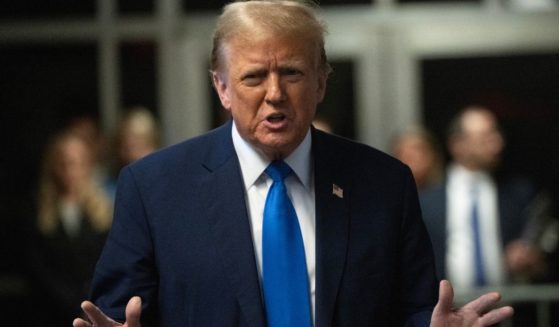Trump Tips Brand-New 'Super-Duper Missile' That Puts China's Best Missiles to Shame
If you’re developing something that’ll put China’s best missiles to shame, what do you dub it? The “super-duper missile,” of course.
The media’s going to seize upon that moniker bestowed upon a new missile tipped by President Donald Trump at the White House on Friday.
It’s made it into pretty much every headline I’ve seen (including ours, to be fair). And, if the missile turns out to live up to the specs laid out at the event, it’s going to be very much worthy of the branding.
The occasion was the unveiling of the official Space Force flag at the White House, but Trump had one more thing to talk about: a new hypersonic missile that would match or beat similar efforts from China and Russia.
“We’re building right now incredible military equipment at a level that nobody’s ever seen before,” Trump said at the news conference.
“We have no choice. We have to do it with the adversaries we have out there. We have, I call it the super-duper missile,” he continued. “I heard the other night, 17 times faster than what they have right now.”
“You’ve heard Russia has five times, and China is working on five or six times, we have one 17 times, and it’s just gotten the go-ahead.”
It’s the “fastest in the world by a factor of almost three,” Trump added.
The media had its usual field day over this one — particularly after the Pentagon refused comment and deferred to the White House, only for White House press secretary Kayleigh McEnany to defer back to the Pentagon.
Update: The White House has referred back to the Pentagon on the “super duper missile.” The circle is complete.
“Yeah I would just refer you back to the president’s remarks & the Pentagon. I don’t have any new information on that at this point,” said press sec Kayleigh McEnany. https://t.co/yVQXKAvdDh
— Elizabeth McLaughlin (@Elizabeth_McLau) May 15, 2020
In response, Pentagon official Jonathan Rath Hoffman tweeted back that they were working on “a range of hypersonic missiles.”
The Department of Defense is working on developing a range of hypersonic missiles to counter our adversaries. https://t.co/ATb1XLHFtl
— Jonathan Rath Hoffman (@ChiefPentSpox) May 15, 2020
So, what is a hypersonic missile?
It’s defined as any missile which goes past Mach 5, or five times the speed of sound. The United States conducted a test of a newly developed hypersonic missile glide body in March, Reuters reported.
The missile follows an unpredictable path, which makes it difficult to neutralize.
It’s fired on a rocket up to 25 miles in the atmosphere, at which point the hypersonic glide body detaches and flies toward the target. This unpredictability is actually why they’re considered so lethal; regular ballistic missiles have a predictable arc, whereas hypersonic glide vehicles can do extraordinary things to evade a country’s missile defenses.
A senior NATO official told Agence France-Presse that in a hypersonic missile strike, the target country wouldn’t know what happened “until there’s a boom on the ground.”
It’s unclear whether this was the missile Trump was referring to in his comments on Friday, but given the context, one would assume it was something else. Both China and Russia have tested hypersonic missiles, and Russia says it has an operable version.
It’s always a good day at the White House when both China and Russia can be put on notice like this. It’s even better when you consider that Russia has used the threat of aiming their putative hypersonic missile arsenal at the United States if we were to deploy intermediate-range ballistic missiles in Europe.
Russia, however, clearly isn’t the main target for the “super-duper missile,” when it arrives.
China has been fairly aggressive about pushing its hypersonic missile, the DF-17. When 16 of them appeared at last year’s National Day parade, the Beijing-friendly South China Morning Post said the “boost-glide missile may be powerful enough to penetrate US missile shields in the region, transforming Beijing’s previously defensive strategy of containing independence-leaning forces in the Taiwan Strait.”
That’s a dangerous statement to begin with, particularly when it comes from a paper that — if certainly not under the heel of the Chinese Communist Party the same way Xinhua news agency or similar propaganda mills are — clearly amplifies pro-Beijing voices.
If Beijing is going to saber-rattle over the issue of Taiwan with its hypersonic missiles, well, the best medicine is to saber-rattle right back.
Mutually assured destruction worked during the Cold War. Even in the 21st century, that paradigm still works.
Every headline seemed to trumpet what the president called the missile. Few seemed to grasp the import of those words.
If this missile can deliver on something even remotely like what the president said it would, the big news from Friday’s news conference won’t be that Space Force flag.
Truth and Accuracy
We are committed to truth and accuracy in all of our journalism. Read our editorial standards.












